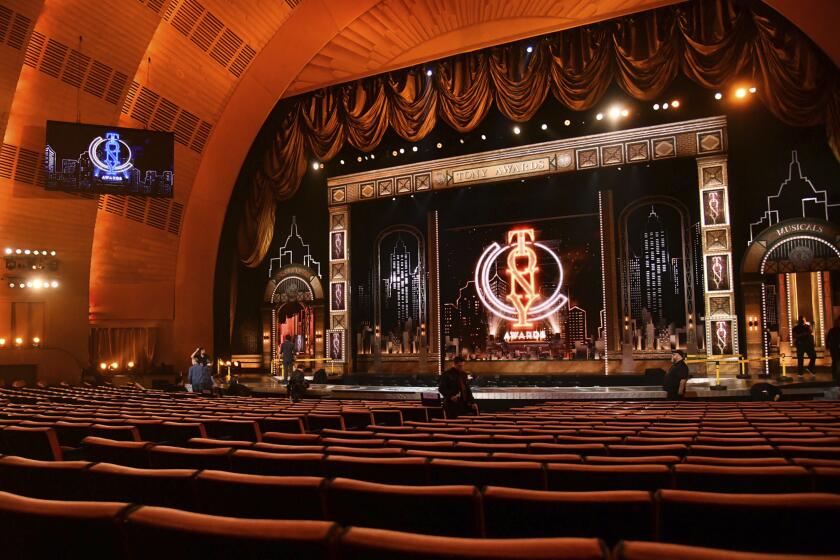ART REVIEW : When to Judge a Book by Its Cover
- Share via
FULLERTON — Rich in colors, textures and unusual shapes and materials, more than 100 books made by fine and graphic artists are the subject of “Metamorphosis: Books Become Art,” a wide-ranging exhibition through March 10 in the lobby of the Cal State Fullerton Library, organized by curator Veronica T. Chiang.
In real life, these books--from the collections of art professor Darryl Curran, book dealers James and Joan Lorson and several artists--are meant to be handled and enjoyed at close range. But until virtual reality comes to the rescue, a public showing of these often fragile pieces encourages only the browsing eye.
Actually, the term “artists’ book” generally refers to a one-of-a-kind or limited-edition handmade volume conceptualized and fabricated by an artist. But this show takes a broader view, encompassing vintage and contemporary handmade and fine-press books as well as practically any artist-made object capable of being opened up--from a decorated box to an accordion-folded piece of paper.
Some artists in the show collaborated with writers, others altered pre-existing printed materials, and still others produced the entire contents of their books.
A combination of social and technological forces made the book format particularly appealing to artists in the 1970s. Conceptual artists were constructing open-ended narratives with texts, sometimes in conjunction with photographs. Feminist artists were making autobiographical works suited to the privacy of the book format. Experimentation with non-traditional media was widespread, with the goal of freeing artists from the economic tyranny of the gallery system and the commodity value of the unique object.
Meanwhile, copy machines had become increasingly ubiquitous and sophisticated. While some artists working with fine art presses paid loving attention to fine materials, others were more intrigued by the possibilities of throwaway materials and cheap reproduction. (In recent years, desktop publishing has increased these options.)
The exhibition includes Ed Ruscha’s seminal “Twentysix Gasoline Stations” from 1962--a deadpan compilation of black-and-white photographs of a forgotten chunk of Americana--as well as some of his subsequent compilations (“Various Small Fires,” “Thirtyfour Parking Lots”).
Among the more recent conceptual pieces, “Keith Smith Meets Evelyn Wood,” by an artist who goes by the name Dunton, is an amusing “speed-reading” parody of Keith Smith’s “Book 91 (String Book),” in which a piece of string travels through punched holes of various sizes on each page. The conceptual books may be high- or low-tech, made from photocopies or plastics, but they deliberately lack the earmarks of a “precious” object.
At the opposite end of the spectrum are many intricate, labor-intensive creations. One of the most ambitious is Joseph D’Ambrosio’s “David,” in which a series of cast paper reliefs imitating Michelangelo’s statue relate to a series of photographs of a nude, modern-day David. Other volumes feature such extravagances as foil stamped and die-cut cover designs, exotic binding materials, original paintings and attached objects (pressed flowers, samples of amber).
Commercial book publishing has gotten in on the act in recent years with such volumes as “The Art Pack” (Knopf), an art history text by Christopher and Helen Frayling and Ron Van der Meer that employs popup imagery and do-it-yourself replications of major technical innovations, such as two-point perspective.
The show also includes a miscellany of older decorated, miniaturized and popup books including poet-artist William Blake’s illustrations for “Songs of Innocence” (1789), a late 19th-Century anatomy book revealing facial structure under a peel-away “skin,” and a vintage German popup circus by Lothar Meggendorfer in which the three-dimensional nature of the wondrous performers contrasts with the flat image of a transfixed audience.
The best thing about this show is its generous inclusiveness, which suggests that there is no limit to the creative possibilities of images and words combined for the private, hands-on delectation of the reader.
* “Metamorphosis: Books Become Art” continues through March 10 in the lobby of the Cal State Fullerton Library, 800 N. State College Blvd., Fullerton. 10 a.m. to 6 p.m. Mondays through Thursdays, noon to 5 p.m. Saturdays. Admission: free. (714) 773-2714.
More to Read
The biggest entertainment stories
Get our big stories about Hollywood, film, television, music, arts, culture and more right in your inbox as soon as they publish.
You may occasionally receive promotional content from the Los Angeles Times.










